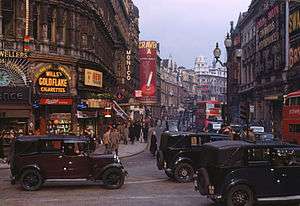Shaftesbury Avenue


Shaftesbury Avenue is a major street in the West End of London, named after Anthony Ashley Cooper, 7th Earl of Shaftesbury, that runs in a north-easterly direction from Piccadilly Circus to New Oxford Street, crossing Charing Cross Road at Cambridge Circus. From Piccadilly Circus to Cambridge Circus it is in the City of Westminster, and from Cambridge Circus to New Oxford Street it is in the London Borough of Camden.
Shaftesbury Avenue was built between 1877 and 1886 by the architect George Vulliamy and the engineer Sir Joseph Bazalgette[1][2] to provide a north-south traffic artery through the crowded districts of St. Giles and Soho. It was also part of a slum clearance measure, to push impoverished workers out of the city centre; although the street's construction was stalled by legislation requiring rehousing some of these displaced residents, overcrowding persisted. Charles Booth's Poverty Map shows the neighbourhood makeup shortly after Shaftesbury Avenue opened. It is generally considered the heart of London's West End theatre district, with the Lyric, Apollo, Gielgud and Queen's theatres clustered together on the west side of the road between Piccadilly Circus and Charing Cross Road. At the intersection of Shaftesbury Avenue and Charing Cross Road there is also the large Palace Theatre. Finally, the north-eastern end of the road has another large theatre, the Shaftesbury Theatre.
The former Saville Theatre is on Shaftesbury Avenue; this became a cinema in 1970, first known as ABC1 and ABC2, and since 2001 as Odeon Covent Garden. Another cinema, the Soho Curzon, is located about halfway along the street.
Between 1899 and 1902, no. 67 Shaftesbury Avenue was the location of the Bartitsu School of Arms and Physical Culture, which holds the distinction of being the first commercial Asian martial arts training school in the Western world.
Shaftesbury Avenue is also a boundary of London's Chinatown. The number of Chinese businesses on the street has been on the increase.[3]
In the evening, street artists gather on the pavement outside the HQ of ICE - International Currency Exchange and Raphaels Bank (previously the home of Natwest) at the Piccadilly Circus end of Shaftesbury Avenue, and produce portraits for the tourists.[4]
In popular culture
Cat Stevens was born in Shaftesbury Avenue.
Shaftesbury Avenue was a film location for, and is mentioned in, Harry Potter and the Deathly Hallows – Part 1.
The street is mentioned in the Dire Straits song "Wild West End", the Momus song "Shaftesbury Avenue," and the Eugene McGuinness song "Wendy Wonders".
A Shaftesbury Avenue road sign is seen on the wall in Edd China's workshop in early episodes of Wheeler Dealers.
In the film 28 Days Later the protagonist Jim (Cillian Murphy), a bicycle courier, was "riding a package from Farringdon to Shaftesbury Avenue and a car cut across [him]." The consequent accident was the cause of his coma, from which he awoke 28 days later.
The 2015 graphic novel trilogy Suffrajitsu: Mrs. Pankhurst's Amazons includes several scenes set in Shaftesbury Avenue, in particular at the Bartitsu Club, which was historically based at no. 67.
See also
Notes
- ↑ Shaftesbury Avenue, volumes 31 and 32: St James Westminster, Part 2, Survey of London, 1963
- ↑ London Sights and Attractions - Shaftesbury Avenue, talkingcities.co.uk, 2006
- ↑ Chinese business directory, Spectrum Radio, Aug 2007
- ↑ Hopes of immortality, New Statesman, Nov 2001
External links
| Wikimedia Commons has media related to Shaftesbury Avenue. |
- Shaftesbury Avenue London W1 — TourUK information
- Survey of London — detailed architectural history
- Lyric Theatre
- Apollo Theatre
- Gielgud Theatre
- Queen's Theatre
- Palace Theatre
- Shaftesbury Theatre
Coordinates: 51°30′43″N 0°07′55″W / 51.512°N 0.132°W
